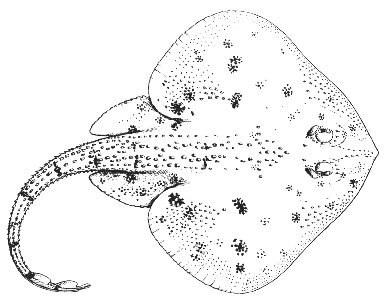Leopard skate Raja garmani Whitley 1939
ROSETTED SKATE
[Bigelow and Schroeder, 1953, p. 200.]
[Garman, 1913, pl. 18, fig. 2.]

Figure 28.—Leopard skate (Raja garmani), female, 16 inches long, offing of Montauk Point, New York. From Bigelow and Schroeder. Drawing by E. N. Fischer.
Description—
The conspicuous dark rosettes on the upper surface make this skate recognizable at a glance, since no other skate of the western Atlantic is marked in this way. And its tail is longer relatively than that of any other Gulf of Maine skate.
The disc is considerably blunter in front than a right angle, with anterior margins bulging rather conspicuously a little anterior to the level of the eyes; the outer corners of the pectorals are very broadly rounded; the tail measured from the center of the cloaca to the tip is about 1.5 times as long as the body from tip of snout to center of cloaca; and there is a definite gap with one or two thorns between the two dorsal fins.[67]
There are thorns along the ridge of the snout; a row around the inner and posterior margins of the eyes with a few in the space between the latter; a group on each shoulder; and one row along the midbelt of the back and tail in young specimens, increasing to 2 to 6 irregular rows in large ones. In young specimens the skin of the disc, as a whole, and of the tail, is also rough with small prickles, but, most of these are lost with growth, leaving large specimens mostly naked except for the thorns. The lower surface is smooth.
There are 46 to 52 series of teeth in the upper jaw, a few less in the lower, and those of adult males are only a little sharper than those of females.
Color—
The upper side is pale buff or brown, [page 67] freckled with small spots, darker or lighter, and conspicuously marked with dark rosettes, each consisting of a group of 6 or more dark brown or black spots surrounding a dark central spot. The lower surface is white or pale yellow.
Size—
This is one of the smaller skates, males maturing when only about 16 inches long.
General range—
Outer part of the continental shelf and upper part of the continental slope from southern Florida to the offing of Nantucket, in depths of 30 to 300 fathoms.
Occurrence in the Gulf of Maine—
Our only reason for mentioning this species is that one specimen was trawled by the Albatross III, May 14, 1950, at 52 fathoms southeast of Nantucket Lightship (lat. 40°05' N., long. 69°22' W.). And this is probably close to the eastern boundary of its range, for it has never been reported among the other skates that are trawled in abundance along the seaward slopes of Georges and of the Nova Scotia Banks. But it is one of the most plentiful of skates offshore to the westward, along southern New England.